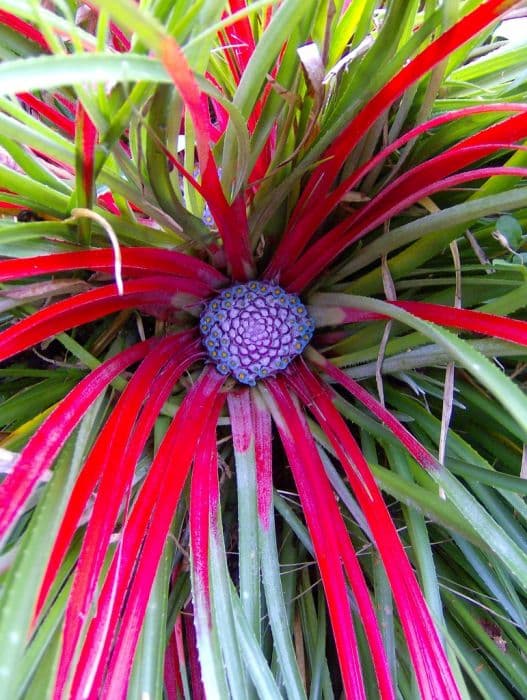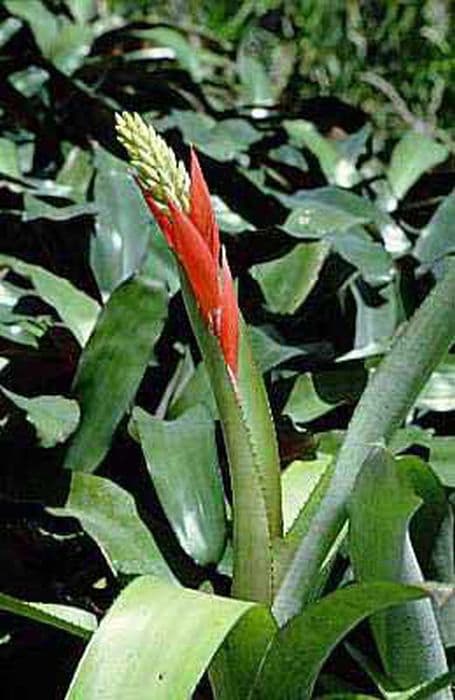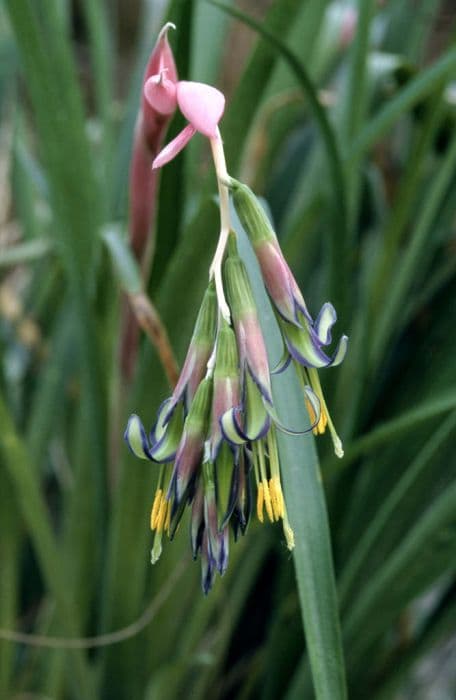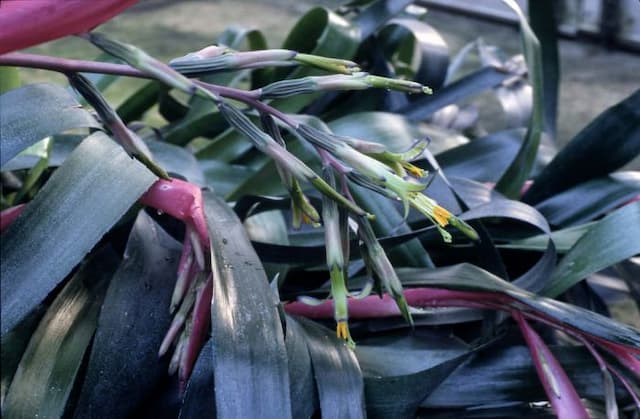Chilean wheel plant Fascicularia bicolor

ABOUT
Fascicularia bicolor, commonly known as the Blue Flame or Hardy Pineapple is a striking plant with an appearance that captures attention. This terrestrial bromeliad has a rosette-forming habit, creating a circular ensemble of long, thin, and spiky leaves. The foliage is a deep green color, often with spiny edges that demand careful handling. What makes this plant particularly unique is the dramatic color change it undergoes when it's about to flower: the center of the rosette turns an intense, vivid red, providing a colorful spectacle that contrasts with the green of the outer leaves. Flowers emerge from the center of this red zone, small and blue, adding a surprising hue to an already eye-catching display. These flowers cluster together, nestled within the reddened leaves, making the heart of the plant resemble a flame - hence the common name, Blue Flame. The contrast of the blue and red colors against the greenery gives this plant a patriotic palette, often related to a visual similarity with a brightly colored firework. Overall, the Blue Flame's appearance is both rugged, with its tough, spiny leaves, and exotic, with its brightly colored and unusual flowering process. This combination of features makes it a popular choice for gardeners looking to add a touch of the tropics and a bold visual statement to their plant collections.
About this plant
 Names
NamesFamily
Bromeliaceae
Synonyms
Chilean Bromeliad, Hardy Pineapple
Common names
Fascicularia bicolor var. canaliculata, Fascicularia bicolor var. lilacina, Fascicularia canaliculata, Fascicularia denticulata, Fascicularia kirchhoffii, Fascicularia montana, Fascicularia pumila, Fascicularia quillotana, Ochagavia bicolor, Tillandsia bicolor.
 Toxicity
ToxicityTo humans
Fascicularia bicolor, more commonly known as Hardy Bromeliad, is not known to be toxic to humans. There are generally no adverse effects reported from ingesting parts of this plant. However, it is always advisable to be cautious and avoid consuming any plant material unless it is known to be edible, as individual reactions can vary.
To pets
The Hardy Bromeliad is also not known to be toxic to pets. It should not cause any harmful effects if pets happen to ingest parts of it. As with human ingestion, it's still a good practice to prevent pets from eating plants since individual pets may have different sensitivities or allergic reactions.
 Characteristics
CharacteristicsLife cycle
Perennials
Foliage type
Evergreen
Color of leaves
Green
Flower color
Blue
Height
1 foot (0.3 meters)
Spread
2 feet (0.6 meters)
Plant type
Bromeliad
Hardiness zones
9
Native area
Chile
Benefits
 General Benefits
General Benefits- Aesthetic Appeal: Fascicularia bicolor, also known as "Chilean hardy bromeliad," adds vibrant color to gardens with its bright red center and blue-tinted leaves during the blooming season.
- Drought Tolerance: Adapted to survive in dry conditions, Chilean hardy bromeliad is suitable for xeriscaping, requiring less water compared to other garden plants.
- Low Maintenance: This plant requires minimal care once established, making it a convenient choice for gardeners seeking plants that do not demand extensive upkeep.
- Attracts Wildlife: The Chilean hardy bromeliad can attract birds and pollinators, such as bees, to the garden when in flower, supporting local biodiversity.
- Cold Resistance: Able to withstand cooler temperatures, this plant is suitable for gardens in temperate regions where other bromeliads may not survive.
- Architectural Interest: Fascicularia bicolor offers striking form and texture, ideal for creating a focal point or adding structure to garden designs.
 Medical Properties
Medical PropertiesThis plant is not used for medical purposes.
 Air-purifying Qualities
Air-purifying QualitiesThis plant is not specifically known for air purifying qualities.
 Other Uses
Other Uses- Fascicularia bicolor, commonly known as Chilean hardy bromeliad, can be used as a natural dye source. The leaves may contain compounds that could be used to create greenish or yellowish hues in textiles.
- Due to its striking appearance when in bloom, the Chilean hardy bromeliad is often used in floral arrangements and as a live decoration at events and ceremonies.
- The fibers from the leaves of Fascicularia bicolor can be utilized in the making of small, artisanal crafts such as woven mats or baskets.
- In landscaping, Chilean hardy bromeliad can be used to stabilize slopes and prevent erosion due to its root system that holds the soil together.
- The plant's ability to hold water in its rosette makes it a potential small habitat or micro-ecosystem for insects and small organisms in a garden ecosystem.
- Chilean hardy bromeliad may be incorporated into green roofs or living wall designs, given its hardiness and minimal soil requirements.
- When the Chilean hardy bromeliad is not in bloom, the spiky texture and form of its leaves can be utilized to add contrast and interest in rock gardens or xeriscape designs.
- In educational settings, Fascicularia bicolor can be used as a specimen for teaching botany and plant physiology, particularly on the topic of bromeliads and their adaptations.
- This plant can act as a natural barrier or hedge when planted in a tight row, deterring small animals and individuals from walking through due to its spiky foliage.
- As an evergreen, the Chilean hardy bromeliad can be used in gardens to maintain year-round visual interest, especially in regions with mild winters where the plant can thrive outdoors.
Interesting Facts
 Feng Shui
Feng ShuiThe Fascicularia is not used in Feng Shui practice.
 Zodiac Sign Compitability
Zodiac Sign CompitabilityThe Fascicularia is not used in astrology practice.
 Plant Symbolism
Plant Symbolism- Adaptability: Fascicularia bicolor, commonly known as the Hardy Bromeliad, often grows in tough conditions on cliff sides and rocky areas, symbolizing the ability to adapt and thrive in difficult environments.
- Unique Beauty: With its stunning silver-green foliage and bright red center when in bloom, the Hardy Bromeliad represents the beauty that is unique and stands out from the surroundings.
- Resilience: The Hardy Bromeliad's durability and capacity to withstand various climates make it a symbol of resilience and toughness, able to endure and maintain its beauty through adversity.
- Protection: The leaves of the Hardy Bromeliad grow tightly together, forming a protective rosette around the central flower, this can symbolize shelter and the importance of safeguarding what is precious.
- Surprise: The plant's inconspicuous nature that leads to a surprising burst of color in its center can symbolize the unexpected pleasures and surprises life may bring.
 Water
WaterThe commonly known Fascicularia bicolor, or Hardy Bromeliad, should be watered sparingly, as this plant is tolerant of drought. Watering should be done when the top inch of soil feels dry to the touch, which typically means every 7 to 10 days. Use approximately 8 to 16 ounces of water each time for smaller plants in pots, and scale up depending on the size of the plant and pot. During the winter season, reduce the frequency of watering as plant growth slows down.
 Light
LightHardy Bromeliad thrives in bright, indirect light, making it ideal for a spot that receives filtered sunlight for most of the day. It can tolerate some direct sun, but in very hot climates, it is best to provide shade during the intense afternoon hours. Do not place the Fascicularia bicolor in deep shade, as this will hinder its growth and vibrant coloration.
 Temperature
TemperatureFascicularia bicolor, also known as Hardy Bromeliad, prefers temperatures between 60 and 75 degrees Fahrenheit for optimal growth, but can survive in temperatures as low as 20 degrees and as high as 90 degrees Fahrenheit. It should be protected from frost, which means if the temperature starts to dip below 40 degrees Fahrenheit, consider moving the plant to a warmer location.
 Pruning
PruningPruning the Hardy Bromeliad is mostly done to remove dead or dying leaves and to maintain the plant's shape. Pruning should be done carefully with clean, sharp scissors or pruning shears. It is best to prune Fascicularia bicolor as needed, typically once or twice a year, and the best time for pruning is in the spring or early summer after the plant has finished blooming.
 Cleaning
CleaningAs needed
 Soil
SoilThe Chilean hardy pineapple plant prefers a well-draining soil mix with loamy or sandy composition. An ideal pH for the soil should range between 5.5 and 7.0. A suitable mix might include two parts sand or perlite, one part peat, and one part pine bark.
 Repotting
RepottingChilean hardy pineapple plants don't need frequent repotting and can be done every 2-3 years. They have a relatively small root system, so repot when the plant outgrows its current pot or the soil looks exhausted.
 Humidity & Misting
Humidity & MistingChilean hardy pineapple plants thrive in moderate humidity, ideally around 40-50%. They are fairly tolerant of a range of humidity levels but do not fare well in overly dry environments.
 Suitable locations
Suitable locationsIndoor
Ensure bright light, well-draining soil, and water sparingly.
Outdoor
Plant in well-draining soil, full sun to part shade.
Hardiness zone
9-11 USDA
 Life cycle
Life cycleThe life of Fascicularia bicolor, commonly known as the hardy bromeliad, starts with seed germination, where environmental conditions such as light, moisture, and temperature trigger the process. After germination, seedlings establish themselves and develop into a rosette of narrow, spiny leaves, which is the vegetative growth stage where the plant matures and increases in size. During this time, the plant may also reproduce vegetatively through offsets or "pups" that grow at the base of the parent plant. Once mature, the hardy bromeliad enters the flowering stage, characterized by a dramatic change in the center leaves to bright red and the emergence of a blue or sometimes white flower spike, attracting pollinators. After pollination and fruit development, seeds are produced, allowing for dispersal and the completion of the reproductive cycle. Eventually, the parent plant dies, leaving behind its offsets to continue the growth cycle.
 Propogation
PropogationPropogation time
Spring-Early Summer
The Chilean hardy bromeliad, Fascicularia bicolor, is most commonly propagated through offset division. This plant will naturally produce small offsets, also known as "pups," which can be separated from the mother plant. The ideal time to do this is late spring or early summer when the plant’s growth is most active. To propagate by division, carefully remove the offsets when they have formed their own roots, usually when they are about a third of the size of the parent plant. It is important to use a clean, sharp knife or garden shears to make the cut to avoid infection and to ensure a quick recovery. After separation, the offsets can be planted in well-draining soil and kept in a warm, bright location to establish their own root systems before being moved to their final location.









